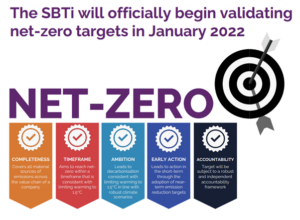The Science Based Targets initiative (SBTi) have launched their corporate net-zero standard.
The standard can be found at https://sciencebasedtargets.org/resources/files/Net-Zero-Standard.pdf
Antaris are advocates of science-based targets and we think they are a great tool to plan for decarbonisation. We have committed to reducing our absolute scope 1 and scope 2 GHG emissions 50% by 2030 from a 2018 base year, and to measure and reduce our scope 3 emissions, and have had our targets validated by the SBTi.
We welcome this new net-zero standard which we think will set a solid framework for net-zero pledges and bridge the gap between distant aspirations and more immediate, wider action, accompanied by greater transparency.
Who are the SBTi?
The Science Based Targets initiative (SBTi) is a global body enabling businesses to set ambitious emissions reductions targets in line with the latest climate science.
![]()
What are science-based targets?
Science-based targets help companies determine how much and how fast they need to reduce GHG emissions to align with efforts to limit warming to 1.5°C. 
Source: https://sciencebasedtargets.org/
What is net-zero?
Net-zero is where the greenhouse gas emissions are equal to the greenhouse gas removals. To reach net-zero we need to massively reduce emissions AND increase removals. But the priority needs to be on eliminating emissions. It is absolutely not the case that we can stay emitting greenhouse gases and in the hope that some sci-fi technology will come along and eliminate all the greenhouse gases.
Source: https://sciencebasedtargets.org/
Net-zero pledges
Net-zero pledges are becoming mainstream. Countries and companies that have made net-zero pledges are tracked on https://www.zerotracker.net/.
Source: zerotracker.net
However, there are concerns that these pledges may be inherently flawed where they are not binding, are not accompanied by a detailed plan, do not cover upstream or downstream emissions, push out milestones decades into the future and/or rely on carbon credits.
In short, the criticisms of the net-zero pledges can be summarized as having one or more of the following:
- Incomplete boundary: Selective inclusion of emission sources incorporate net-zero targets
- Delayed action: Lack of interim milestones for long-term targets.
- Mitigation deterrence: Focus on offsetting instead of on reducing emissions.
- Poor accountability: Lack of scrutiny and accountability on voluntary commitments.
Why has the SBTi developed a net-zero standard?
The SBTi have produced this standard as a robust benchmark to address the skepticism around net-zero as a concept.
Source: https://sciencebasedtargets.org/
What are the key requirements of the Net-Zero Standard?
Focus on rapid, deep emission cuts: Rapid, deep cuts to value-chain emissions are the most effective and scientifically-sound way of limiting global temperature rise to 1.5°C. This is the central focus of the Net-Zero Standard and must be the overarching priority for companies. The Net-Zero Standard covers a company’s entire value chain emissions, including those produced by their own processes (scope 1), purchased electricity and heat (scope 2), and generated by suppliers and end-users (scope 3). Most companies will require deep decarbonization of 90-95% to reach net-zero under the Standard.
Set near- and long-term targets: Companies adopting the Net-Zero Standard are required to set both near-term and long-term science-based targets. This means making rapid emissions cuts now, halving emissions by 2030. By 2050, organizations must produce close to zero emissions and will neutralise any residual emissions that are not possible to eliminate.
No net-zero claims until long-term targets are met: A company is only considered to have reached net-zero when it has achieved its long-term science-based target. Most companies are required to have long-term targets with emission reductions of at least 90-95% by 2050. At that point, a company must use carbon removals to neutralize any limited emissions that cannot yet be eliminated.
Go beyond the value chain: The SBTi recommends Companies go further by making investments outside their science-based targets to help mitigate climate change elsewhere. There is an urgent need to scale up near-term climate finance; however, these investments should be in addition to deep emission cuts, not instead of them. Companies should follow the mitigation hierarchy, committing to reduce their value chain emissions before investing to mitigate emissions outside their value chains.
At Antaris, we get a kick out of helping our clients transform their vision statements around sustainability into tangible actions, and we are glad to have another valuable tool in our arsenal to help move planning to action.
Want to know more about the technical details
Check out the documents below or find out more on the SBTi net-zero webpage at https://sciencebasedtargets.org/net-zero
Want to talk to us about decarbonisation or sustainability strategies?
Contact us at +353 (0)61 953100 or info@antarisconsulting.com














